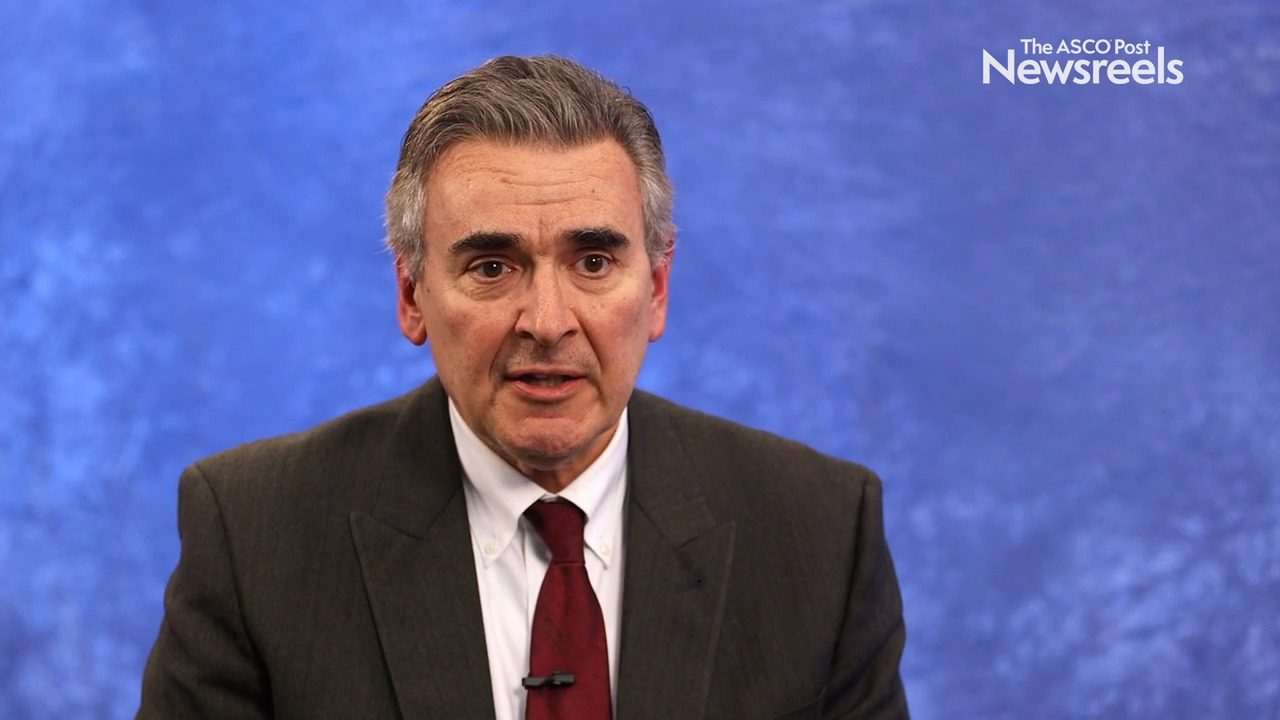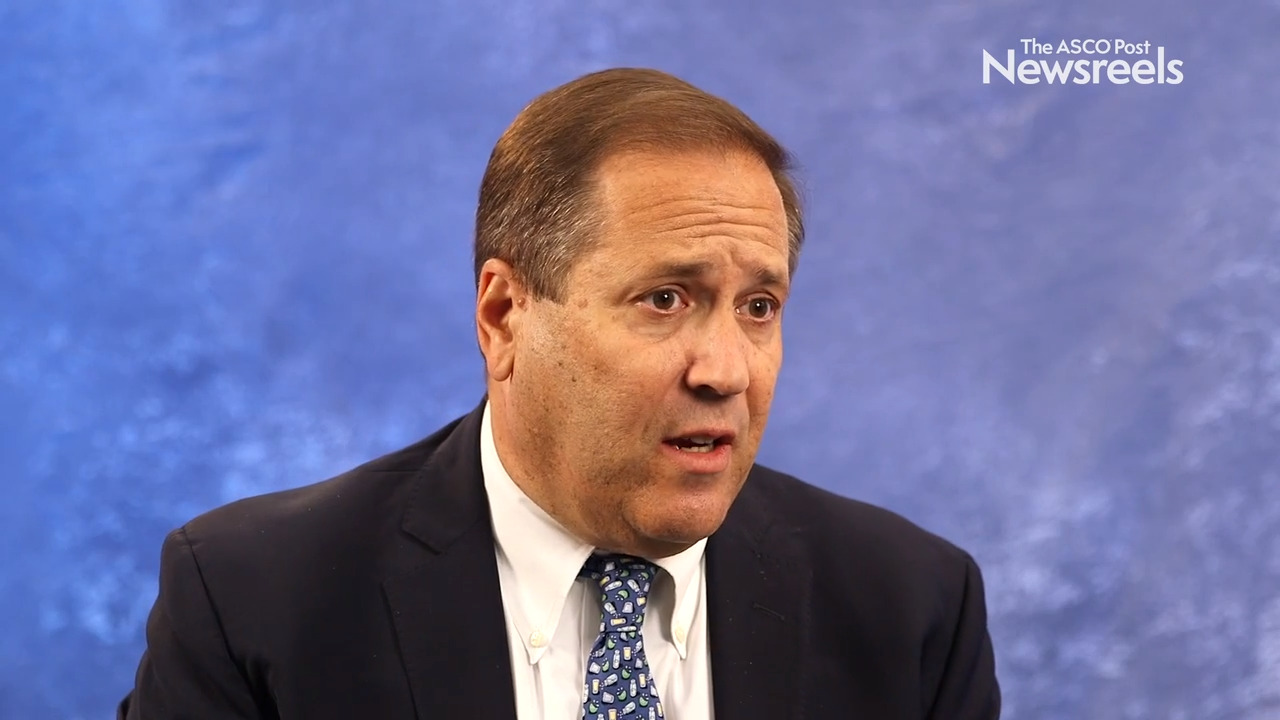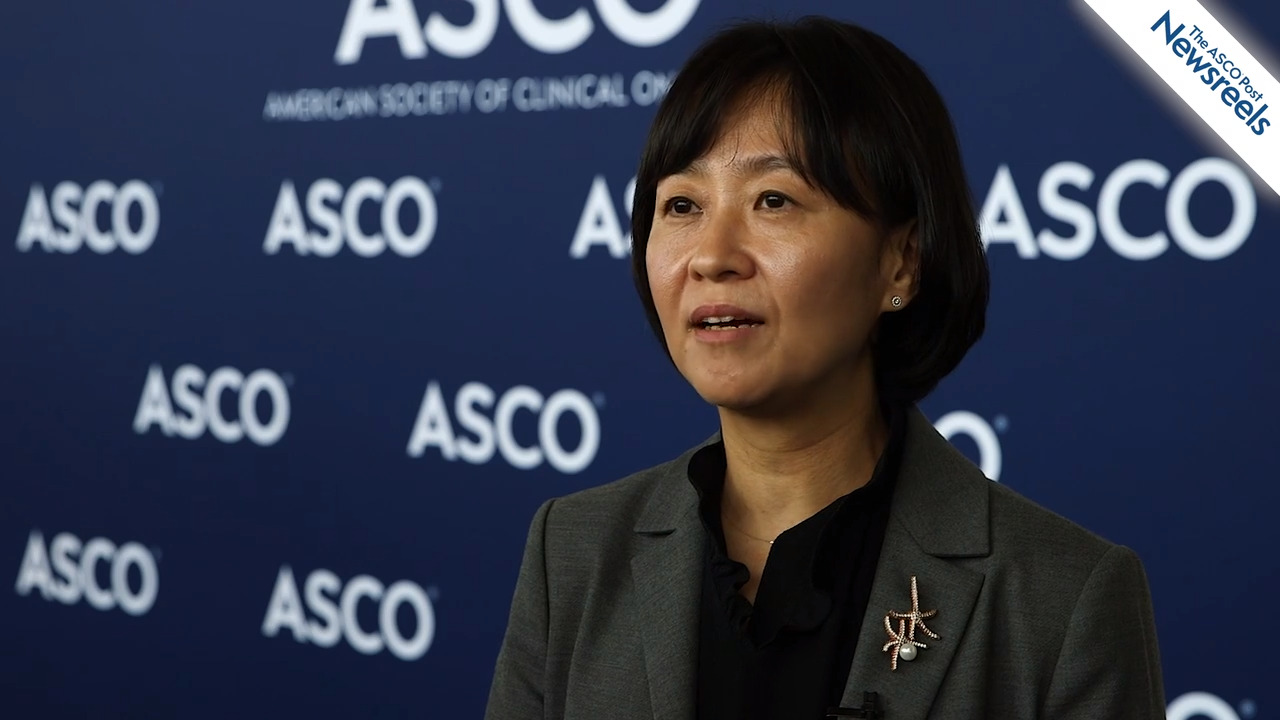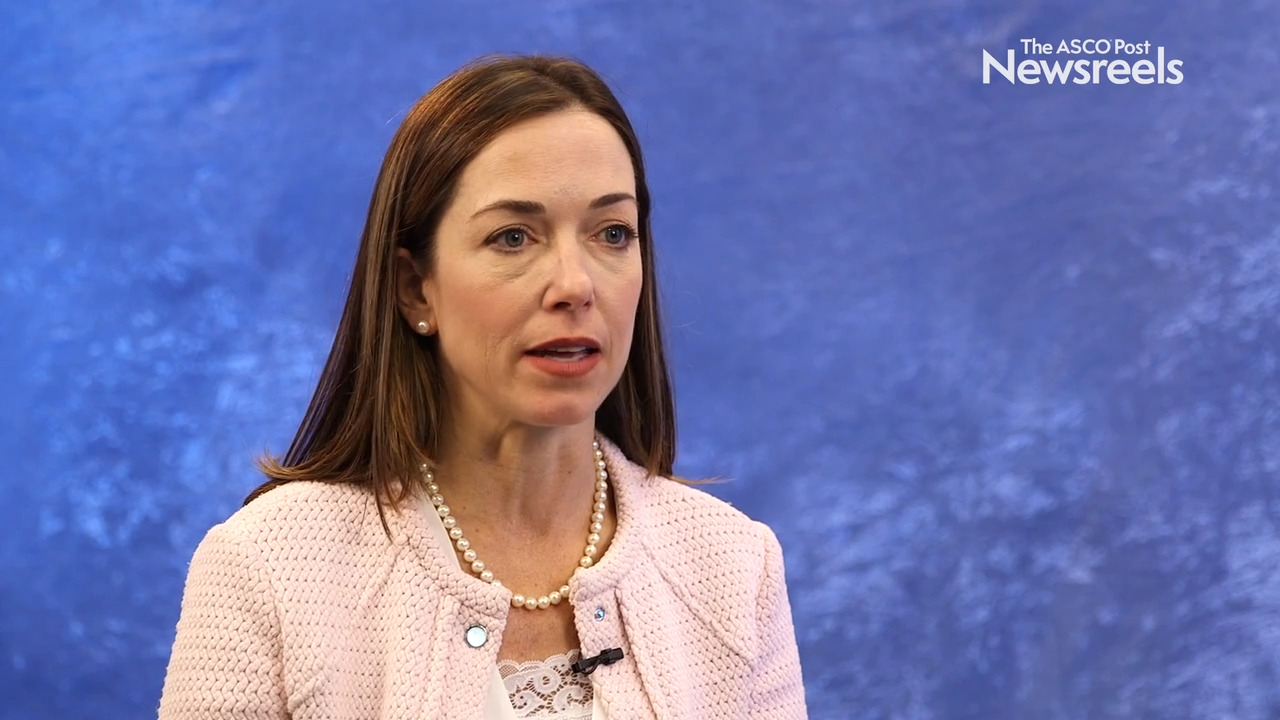Peter Schmid, MD, PhD, and Hope S. Rugo, MD, on Breast Cancer: Next Steps in Immunotherapy
Hope S. Rugo, MD, of the University of California, San Francisco, and Peter Schmid, MD, PhD, of Barts Cancer Institute, Queen Mary University of London, discuss ongoing trials of immunotherapy for early triple-negative breast cancer; immunotherapy in other disease subtypes such as estrogen receptor–positive and HER2-positive; and checkpoint inhibition in PD-L1–negative disease.
2019 ASCO: New TAILORx Data Provide Treatment Guidance for Women Under 50 With Early Breast Cancer
New information about adjuvant therapy to prevent recurrence of breast cancer in women 50 years of age or younger has emerged from the Trial Assigning Individualized Options for Treatment (Rx), or TAILORx. An analysis of a prespecified secondary endpoint in this trial found that an assessment of a ...
Peter Schmid, MD, PhD, and Hope S. Rugo, MD, on Metastatic Triple-Negative Breast Cancer: Atezolizumab Plus Nab-paclitaxel
Hope S. Rugo, MD, of the University of California, San Francisco, and Peter Schmid, MD, PhD, of Barts Cancer Institute, Queen Mary University of London, discuss an update of the IMpassion130 interim overall survival analysis of atezolizumab plus nab-paclitaxel in previously untreated locally advanced or metastatic triple-negative breast cancer (Abstract 1003).
Hope S. Rugo, MD, and Matteo Lambertini, MD, PhD, on the SOPHIA Trial in HER2-Positive Metastatic Breast Cancer: Chemotherapy Plus Margetuximab vs Trastuzumab
Matteo Lambertini, MD, PhD, of the University of Genova and Policlinico San Martino Hospital, and Hope S. Rugo, MD, of the University of California, San Francisco, discuss findings from the SOPHIA trial on margetuximab plus chemotherapy vs trastuzumab plus chemotherapy in patients with HER2-positive metastatic breast cancer after prior anti-HER2 therapies (Abstract 1000).
Joseph A. Sparano, MD, on Early Breast Cancer: Predicting Prognosis and Treatment Benefit in TAILORx
Joseph A. Sparano, MD, of the Montefiore Medical Center and Albert Einstein Cancer Center, discusses how clinical risk stratification provides additional prognostic information to the 21-gene recurrence score and may be used to identify premenopausal women for more effective antiestrogen therapy (Abstract 503).
Matteo Lambertini, MD, PhD, on Safety of Pregnancy After Treatment for BRCA-Mutated Breast Cancer
Matteo Lambertini, MD, PhD, of the University of Genova and Policlinico San Martino Hospital, discusses data from an international cohort study on counseling women with breast cancer who have a BRCA mutation about the safety of becoming pregnant once they complete treatment (Abstract 11506).
Sara A. Hurvitz, MD, on HER2-Positive Breast Cancer: KRISTINE Trial on Neoadjuvant Trastuzumab, Pertuzumab, and Chemotherapy
Sara A. Hurvitz, MD, of the David Geffen School of Medicine, University of California Los Angeles, discusses 3-year outcomes from the first phase III study to test a non-conventional regimen for the neoadjuvant and adjuvant treatment of HER2-positive breast cancer (Abstract 500).
Medicaid Expansion and Colorectal Cancer Screening
A new study examining Medicaid expansion and cancer screening found that the five states and District of Columbia that first adopted Medicaid expansion saw larger increases in colorectal cancer screening than states that did not expand Medicaid. The study—published by Fedewa et al in...
Studies Report Early Success With Same-Day Mastectomy and Home Recovery Programs
Patients can safely recover from mastectomy at home, according to two studies reported at the 2019 American Society of Breast Surgeons Annual Meeting.1,2 The studies examined outcomes after implementation of comprehensive postmastectomy surgical home recovery programs, showing that they...
Nipple-Sparing Mastectomy May Be Suitable for Growing Number of Well-Selected Patients
As nipple-sparing mastectomy gains favor, it is being performed on a broader spectrum of patients once considered off limits by surgeons. A Mayo Clinic study in a contemporary cohort found no increase in complication rates or decrease in reconstruction success with this surgical approach.1 “We...
Using Bioimpedance Spectroscopy to Prevent Progression of Lymphedema
Surveillance of women at risk for breast cancer–related lymphedema using bioimpedance spectroscopy was more effective in preventing lymphedema progression than traditional measurement of arm circumference, when each is combined with immediate compression therapy. These findings came from the...
Alpelisib Plus Fulvestrant Approved for PIK3CA-Mutated Breast Cancer
On May 24, the U.S. Food and Drug Administration (FDA) approved the PIK3CA inhibitor alpelisib (Piqray) tablets to be used in combination with the FDA-approved endocrine therapy fulvestrant to treat postmenopausal women and men with hormone receptor–positive, HER2-negative, PIK3CA-mutated, advanced ...
MONALEESA-7 Shows Overall Survival Benefit for Ribociclib/Endocrine Therapy
The first statistically significant overall survival benefit has been shown for a cyclin-dependent kinase (CDK) 4/6 inhibitor plus endocrine therapy as first-line treatment of advanced breast cancer. The results are from the phase III MONALEESA-7 trial, which evaluated ribociclib plus endocrine...
Adam Brufsky, MD, PhD, on HER2-Positive Metastatic Breast Cancer: NALA Trial on Neratinib vs Lapatinib Plus Capecitabine
Adam Brufsky, MD, PhD, of Magee-Womens Hospital and the Hillman Cancer Center at the University of Pittsburgh Medical Center, discusses phase III study findings on neratinib plus capecitabine vs lapatinib plus capecitabine in patients previously treated for HER2-positive metastatic breast cancer (Abstract 1002).
Jame Abraham, MD, on NALA Trial Findings in HER2-Positive Metastatic Breast Cancer
Jame Abraham, MD, of the Cleveland Clinic, provides commentary on the NALA study findings on neratinib plus capecitabine vs lapatinib plus capecitabine in patients previously treated with HER2-positive metastatic breast cancer (Abstract 1002).
Yeon Hee Park, MD, on Metastatic Breast Cancer: Palbociclib, Exemestane, and GnRH Agonist
Yeon Hee Park, MD, of the Samsung Medical Center, discusses phase II study findings that showed exemestane plus palbociclib with ovarian suppression improved progression-free survival compared with capecitabine in premenopausal estrogen receptor–positive metastatic breast cancer (Abstract 1007).
2019 ASCO: Partial- vs Whole-Breast Irradiation in Early-Stage Breast Cancer
Partial-breast irradiation produces similar long-term survival rates and risk for recurrence compared with whole-breast irradiation for many women with low-risk, early-stage breast cancer, according to new data from the NRG Oncology/NSABP B-39/RTOG 0413 trial. Results were presented by Ganz et al...
Sara A. Hurvitz, MD, on HR+/HER2− Advanced Breast Cancer: MONALEESA-7 Trial on Endocrine Therapy With or Without Ribociclib
Sara A. Hurvitz, MD, of the UCLA Jonsson Comprehensive Cancer Center, discusses the first study of ribociclib plus endocrine therapy vs endocrine therapy alone to demonstrate significantly longer overall survival in peri- and premenopausal women with advanced breast cancer (Abstract LBA1008).
Patricia A. Ganz, MD, on Breast Cancer: Whole- vs Partial-Breast Irradiation
Patricia A. Ganz, MD, of NRG Oncology and Jonsson Comprehensive Cancer Center at UCLA, discusses the NRG/NSABP phase III findings, which showed that partial-breast irradiation was more convenient and resulted in less fatigue but slightly poorer cosmesis at 36 months in patients who did not receive chemotherapy (Abstract 508).
Rowan T. Chlebowski, MD, PhD, on Breast Cancer Incidence and Mortality: Results From the Women’s Health Initiative on the Effects of a Low-Fat Diet
Rowan T. Chlebowski, MD, PhD, of the Los Angeles BioMedical Research Institute at Harbor-UCLA Medical Center, discusses study findings from nearly 2 decades of data, which showed a 21% reduction in deaths from breast cancer among postmenopausal women who adhered to a low-fat diet (Abstract 520).
2019 ASCO: MONALEESA-7: Addition of Ribociclib to Endocrine Therapy in Premenopausal Women With HR-Positive, HER2-Negative Breast Cancer
The international, randomized phase III MONALEESA-7 trial found that the addition of ribociclib to standard-of-care endocrine therapy significantly improved overall survival for premenopausal women with advanced hormone receptor (HR)-positive, HER2-negative breast cancer compared with endocrine...
GeparSepto: Long-Term Clinical Outcomes With Neoadjuvant Nab-paclitaxel vs Solvent-Based Paclitaxel in Early Breast Cancer
As reported in the Journal of Clinical Oncology by Untch et al, long-term follow-up in the GeparSepto trial showed that patients with early breast cancer receiving neoadjuvant nab-paclitaxel vs solvent-based paclitaxel followed by epirubicin/cyclophosphamide had better invasive disease–free...
Breast Cancer Specialist Focuses on Educational Side of Oncology, Connecting Patients With Cancer Around the World
Internationally renowned breast cancer specialist Daniel A. Vorobiof, MD, was born in Santa Fe, Argentina, a province in the northeastern region of the country that is prone to catastrophic flooding. Asked about any early influences in his desire to pursue a career in medicine, Dr. Vorobiof...
FDA Approves Alpelisib in Combination With Fulvestrant for PIK3CA-Mutated, Hormone Receptor–Positive Advanced Breast Cancer
On May 24, the U.S. Food and Drug Administration (FDA) approved alpelisib (Piqray) tablets to be used in combination with the FDA-approved endocrine therapy fulvestrant to treat postmenopausal women, and men, with hormone receptor (HR)-positive, human epidermal growth factor receptor 2...
Risk of Subsequent Breast Cancer in Female Childhood Cancer Survivors
As reported by Ehrhardt et al in the Journal of Clinical Oncology, high doses of anthracyclines were associated with increased breast cancer risk in female childhood cancer survivors in the St. Jude Lifetime Cohort Study, with the association being independent of mutations in cancer risk...
Fulvestrant/Anastrozole in Metastatic Breast Cancer
As reported in The New England Journal of Medicine by Rita S. Mehta, MD, and colleagues, the final overall survival results of the phase III SWOG S0226 trial show that the addition of first-line fulvestrant to anastrozole was associated with improved overall survival in postmenopausal women with...
ACP Issues Guidance for Breast Screening in Average-Risk Women
AVERAGE-RISK women between the ages of 50 and 74 who have no symptoms of breast cancer should undergo breast cancer screening with mammography every other year, the American College of Physicians (ACP) has recommended in a new evidence-based guidance statement published by Qaseem et al in Annals of ...
Ghanaian Oncologist Yehoda M. Martei, MD, Seeks Ways to Improve Outcomes in the Developing World
Breast cancer remains the most commonly diagnosed cancer among women globally. Due to a lack of early interventions, most women in low- and middle-income countries have advanced disease at the time of diagnosis, conferring a grim prognosis. Yehoda M. Martei, MD, of the Department of Medicine,...
Risk of Breast Cancer Among Transgender People
In a Dutch study published by de Blok et al in The BMJ, researchers found an increased risk of breast cancer in transgender women compared with cisgender men, and a lower risk of breast cancer in transgender men than in cisgender women. Methods This retrospective, nationwide cohort study...
Study Finds Timing of Therapy Does Not Influence Outcomes in HER2-Positive Breast Cancer
The sequencing of trastuzumab administration with chemotherapy in the neoadjuvant setting seems to have no effect on outcomes for patients with HER2-positive breast cancer, according to data presented at the 2019 Society of Surgical Oncology Annual Cancer Symposium.1 The results of a phase III...
Locoregional Recurrence After Mastectomy for DCIS More Common Among Younger Women, Study Finds
Young age appears to be a risk factor for locoregional recurrence after mastectomy for ductal carcinoma in situ (DCIS) with or without microinvasion, according to data presented at the 2019 Society of Surgical Oncology Annual Cancer Symposium.1 The retrospective analysis of more than 3,000 cases...
Trastuzumab Emtansine in Treatment of Residual Breast Cancer After Neoadjuvant Therapy: Who Will Benefit?
The discovery of trastuzumab has been revolutionary in the treatment of HER2-positive breast cancer, both in the metastatic and early-stage settings.1-6 This cannot be disputed. In the early-stage setting, the addition of trastuzumab to standard chemotherapy has led to a 50% gain in...
Adjuvant Trastuzumab Emtansine vs Standard Trastuzumab in Residual HER2-Positive Breast Cancer After Neoadjuvant Therapy
In the phase III KATHERINE trial reported in The New England Journal of Medicine,1Gunter von Minckwitz, MD, of the German Breast Group, Neu-Isenburg, and colleagues found that adjuvant treatment with the antibody-drug conjugate trastuzumab emtansine (T-DM1) improved invasive disease–free survival...
ACCURE Trial: Improving Racial Disparities in Treatment for Patients With Early-Stage Lung and Breast Cancers
Results from a study published by Cykert et al in The Journal of the National Medical Association show that a pragmatic system-based intervention within cancer treatment centers can nearly eliminate existing disparities in treatment and outcomes for black patients with early-stage...
FDA Approves T-DM1 for HER2-Positive Early Breast Cancer
On May 3, the U.S. Food and Drug Administration (FDA) approved ado-trastuzumab emtansine (T-DM1; Kadcyla) for the adjuvant treatment of patients with HER2-positive early breast cancer who have residual invasive disease after neoadjuvant taxane- and trastuzumab-based treatment. Patients should be...
Digital Breast Tomosynthesis vs Digital Mammography in a Breast Cancer Screening Program
In a Norwegian study (To-Be) reported in The Lancet Oncology, Hofvind et al found that digital breast tomosynthesis (including synthetic 2D mammograms) did not perform better than standard digital mammography in a population-based breast cancer screening program. Study Details BreastScreen Norway ...
NCCN Clinical Practice Guidelines in Oncology: 2019 Updates
In 1996, the National Comprehensive Cancer Network® (NCCN®) published its first set of Clinical Practice Guidelines in Oncology (NCCN Guidelines®), covering eight tumor types. NCCN Guidelines are now published for more than 70 tumor types and topics. Some of the key updates for 2019 were presented...
Trastuzumab Deruxtecan in Advanced HER2-Positive Gastric and Breast Cancers
Two phase I studies reported in The Lancet Oncology indicate activity of the antibody-drug conjugate trastuzumab deruxtecan in advanced HER2-positive gastric cancer and advanced HER2-positive breast cancer previously treated with trastuzumab emtansine (T-DM1). Trastuzumab deruxtecan (DS-8201a) is a ...
2019 ASCO: Low-Fat Diet May Reduce the Risk of Death From Breast Cancer in Postmenopausal Women
Excluding skin cancer, breast cancer is the most common cancer diagnosed in women in the United States. In 2019, the American Cancer Society estimates that about 268,600 new cases of breast cancer will be diagnosed in women, and about 41,760 women will die from their disease. ...
Addition of Tucidinostat to Exemestane in Advanced Hormone Receptor–Positive Breast Cancer
In the Chinese phase III ACE trial reported in The Lancet Oncology, Jiang et al found that the addition of the oral histone deacetylase inhibitor tucidinostat to exemestane improved progression-free survival in postmenopausal women with advanced hormone receptor (HR)-positive breast cancer whose...
Lifetime Risk of Brain Metastases in Elderly Survivors of Breast, Lung, and Skin Cancers
Elderly survivors of breast cancer, lung cancer, and melanoma face risk of brain metastasis later in life, and may require extra surveillance in the years following initial cancer treatment, according to results of a study published by Ascha et al in Cancer Epidemiology, Biomarkers, &...
Sentinel Lymph Node Biopsy With or Without Use of Preoperative Lymphoscintigraphy in Early Breast Cancer
In a German/Swiss phase III trial (SenSzi [GBG80]) reported in the Journal of Clinical Oncology, Kuemmel et al found that preoperative lymphoscintigraphy was not associated with an increased number of histologically detected sentinel lymph nodes with sentinel lymph node biopsy in women with early...
ARRS 2019: Short-Interval Follow-up MRI in Identifying Early-Stage Breast Cancer
When appropriate, short-interval follow-up magnetic resonance imaging (MRI) can be used to identify early-stage breast cancer and avoid unnecessary biopsies, according to a study presented by Lamb et al at the American Roentgen Ray Society (ARRS) 2019 Annual Meeting (Abstract 2367). Utilization of ...
FDA Advances Policy Changes to Modernize Mammography Services
ON MARCH 27, 2019, the U.S. Food and Drug Administration (FDA) announced important new steps to modernize breast cancer screening and help empower patients with more information when they are considering important decisions regarding their breast health care. For the first time in more than 20...
Postprogression Treatment of Estrogen Receptor–Positive Breast Cancer: Future Approaches
AT THE 2019 Miami Breast Cancer Conference, William J. Gradishar, MD, FASCO, presented a vision of the future in the treatment of advanced hormone receptor–positive breast cancer.1 The refinement of disease subsets, the development of agents targeting the PI3K/AKT/mTOR pathway, the use of novel...
AACR Study Presentations Include New Data in Breast and Prostate Cancers, Sarcoma, and High-Risk Individuals
THE 2019 American Association for Cancer Research (AACR) Annual Meeting was held March 29 to April 3 in Atlanta. In addition to our regular coverage of news stories from the meeting, here are some brief highlights of additional noteworthy studies. Stage IV HER2-Positive Breast Cancer: Surgery or No ...
FDA Pipeline: Designations in Triple-Negative Breast Cancer, ctDNA Detection
This week, the U.S. Food and Drug Administration (FDA) granted a Fast Track designation to a treatment for CCR5-positive metastatic triple-negative breast cancer; granted Breakthrough Device designation to a test for the postsurgical detection and quantification of circulating tumor DNA (ctDNA);...
ASBrS 2019: Comprehensive Postoperative Mastectomy Home Recovery Programs Show Patient Benefit
Comprehensive postoperative mastectomy home recovery programs significantly increased same-day patient discharge with no decrease in quality of care, according to two new studies presented at the Annual Meeting of the American Society of Breast Surgeons (ASBrS). “Research demonstrates the...
Final Analysis of the HannaH Trial: Perioperative Subcutaneous vs Intravenous Trastuzumab in HER2-Positive Early Breast Cancer
As reported in JAMA Oncology by Jackisch et al, the final analysis of the phase III HannaH trial indicated comparable efficacy and safety of perioperative subcutaneous (SC) vs intravenous (IV) trastuzumab in ERBB2 (HER2)-positive early breast cancer. Earlier reports from the trial showed similar...
ASBrS 2019: Opioid Management Program Reduces Post–Breast Surgery Narcotic Use
A breast surgery opioid prescription management program that analyzed current physician patterns and provided education and guidelines successfully reduced the volume of narcotics given postoperatively to patients at a large institution. These results were presented by Fan et al at the Annual...












